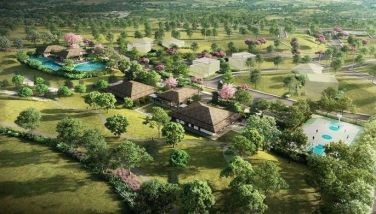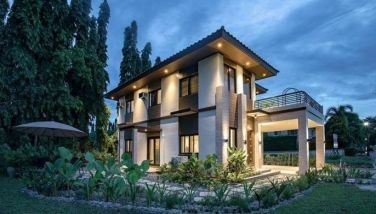Waste plastics good binder for plywood production
August 23, 2003 | 12:00am
LOS BAÑOS, Laguna – Waste plastics can be used as binder for plywood and particleboard production.
This was found in a study done by researchers of the Department of Science and Technology-Forest Products Research and Development Institute (DOST-FPRDI) based here.
The research was done by Hilario Dolores (senior science research specialist), Mildred Fidel (supervising science research specialist), Vicente Mallari Jr. (scientist 1), and Alberto Nicolas (planning officer).
In the study, mixtures of low, medium, and high density polyethylene (LMHPE) waste plastics, waste plastic aluminum packaging laminates (PAPL), and oriented polypropylene laminates (OPL) were used as binders in the production of laboratory and commercial sized 3-ply plywood and one layer particleboard.
Fifty-four laboratory lauan plywood panels measuring 30 centimeters by 30 cm were produced using three pressing times (five, 10, 15 minutes), two pressing temperatures (130oC and 15oC), and three plastic spreads (100 grams per square meter, 120 g/ sq m, and 140 g/sq m) as variables.
Plywood mill testing was conducted using single temperature (130oC), single pressing time (seven minutes), three plastic spreads (60 g/sq m, 120 m/sq m, and 180 g/sq m).
The plywood samples produced were subjected to delamination test and cyclic boil tests following PNS 196:2000 plywood standards.
Results showed that all laboratory plywood samples bonded with LMHPE, PAPL, and OPL passed the delamination test for Type 2 (interior plywood). However, only 16 percent and 61 percent of the samples passed the cyclic boil test for Type 1 (exterior plywood) using mixtures of LMHPE and PAPL/OPL chip binders, respectively.
Commercial-sized plywood measuring 122 cm x 244 cm were produced during mill testing using recycled waste plastic film (RWPF) with 25 percent virgin polyethylene plastics and 75 percent waste PE plastics.
Mill testing was conducted in five plywood mills.
RWP (0.1 mm thick) from various densities of PE plastics was used as binder. Randomly selected panels underwent delamination and cyclic boiling tests following the PNS 196:2000 plywood standards.
Panels with plastic spreads 60 g/sq m, 120 g/sq m, and 180 g/sq m passed the Type 2 plywood standards. Those with higher plastic spreads (120 g/sq m and 180 g/sq m) exhibited excellent bond strength and properties that were comparable with Type 1 plywood.
Waste plastic-bonded laboratory bamboo particleboards at 750 g/cubic meter density were also produced in three combination ratios of bamboo particles and waste plastics (40:60, 50:50, and 30:70).
This was found in a study done by researchers of the Department of Science and Technology-Forest Products Research and Development Institute (DOST-FPRDI) based here.
The research was done by Hilario Dolores (senior science research specialist), Mildred Fidel (supervising science research specialist), Vicente Mallari Jr. (scientist 1), and Alberto Nicolas (planning officer).
In the study, mixtures of low, medium, and high density polyethylene (LMHPE) waste plastics, waste plastic aluminum packaging laminates (PAPL), and oriented polypropylene laminates (OPL) were used as binders in the production of laboratory and commercial sized 3-ply plywood and one layer particleboard.
Fifty-four laboratory lauan plywood panels measuring 30 centimeters by 30 cm were produced using three pressing times (five, 10, 15 minutes), two pressing temperatures (130oC and 15oC), and three plastic spreads (100 grams per square meter, 120 g/ sq m, and 140 g/sq m) as variables.
Plywood mill testing was conducted using single temperature (130oC), single pressing time (seven minutes), three plastic spreads (60 g/sq m, 120 m/sq m, and 180 g/sq m).
The plywood samples produced were subjected to delamination test and cyclic boil tests following PNS 196:2000 plywood standards.
Results showed that all laboratory plywood samples bonded with LMHPE, PAPL, and OPL passed the delamination test for Type 2 (interior plywood). However, only 16 percent and 61 percent of the samples passed the cyclic boil test for Type 1 (exterior plywood) using mixtures of LMHPE and PAPL/OPL chip binders, respectively.
Commercial-sized plywood measuring 122 cm x 244 cm were produced during mill testing using recycled waste plastic film (RWPF) with 25 percent virgin polyethylene plastics and 75 percent waste PE plastics.
Mill testing was conducted in five plywood mills.
RWP (0.1 mm thick) from various densities of PE plastics was used as binder. Randomly selected panels underwent delamination and cyclic boiling tests following the PNS 196:2000 plywood standards.
Panels with plastic spreads 60 g/sq m, 120 g/sq m, and 180 g/sq m passed the Type 2 plywood standards. Those with higher plastic spreads (120 g/sq m and 180 g/sq m) exhibited excellent bond strength and properties that were comparable with Type 1 plywood.
Waste plastic-bonded laboratory bamboo particleboards at 750 g/cubic meter density were also produced in three combination ratios of bamboo particles and waste plastics (40:60, 50:50, and 30:70).
BrandSpace Articles
<
>
- Latest
Latest
Latest
October 23, 2024 - 9:30am
By May Dedicatoria | October 23, 2024 - 9:30am
October 11, 2024 - 3:45pm
October 11, 2024 - 3:45pm
October 10, 2024 - 11:30am
October 10, 2024 - 11:30am
October 5, 2024 - 12:08pm
October 5, 2024 - 12:08pm
September 24, 2024 - 1:00pm
September 24, 2024 - 1:00pm
September 13, 2024 - 4:00pm
September 13, 2024 - 4:00pm
Recommended


























